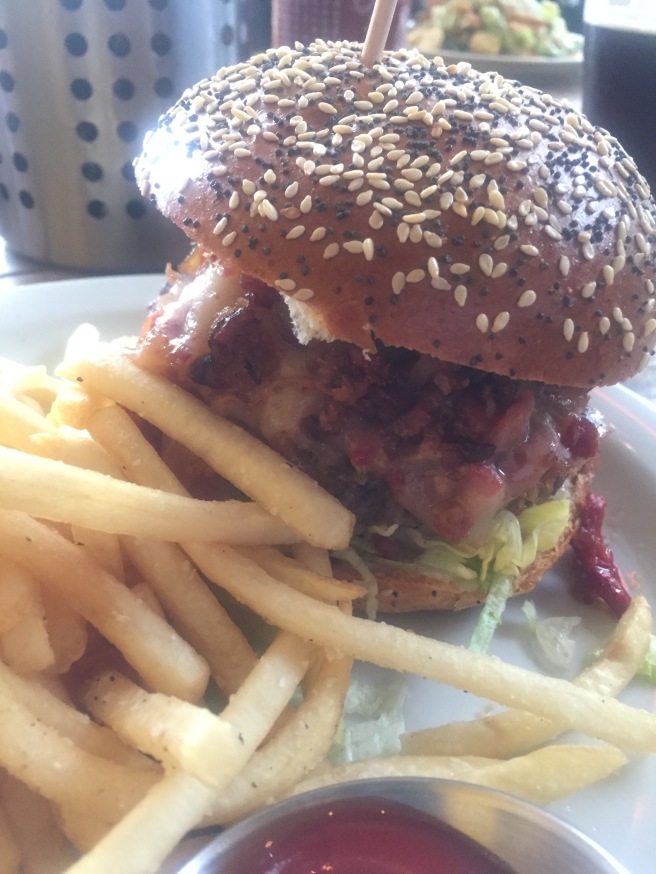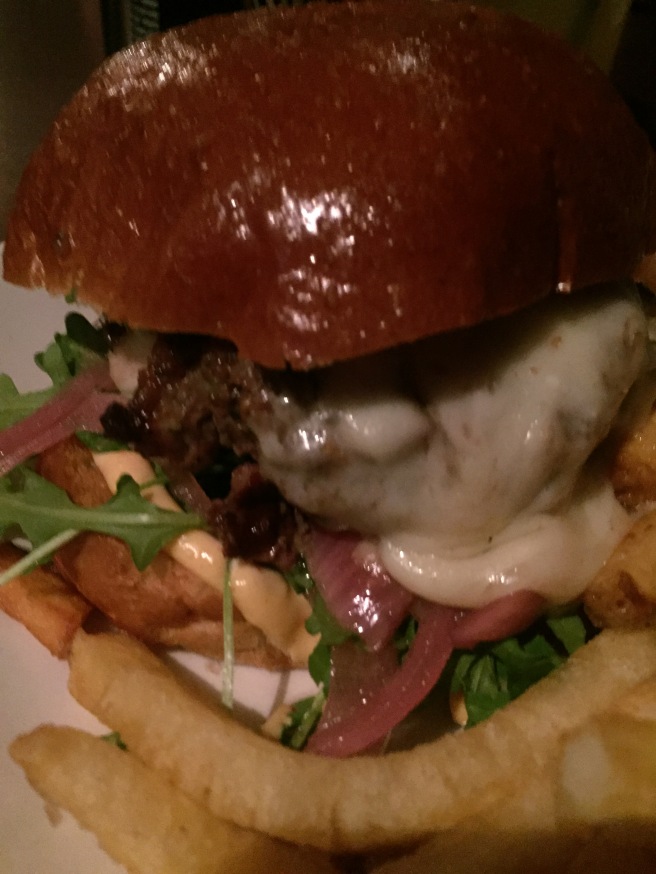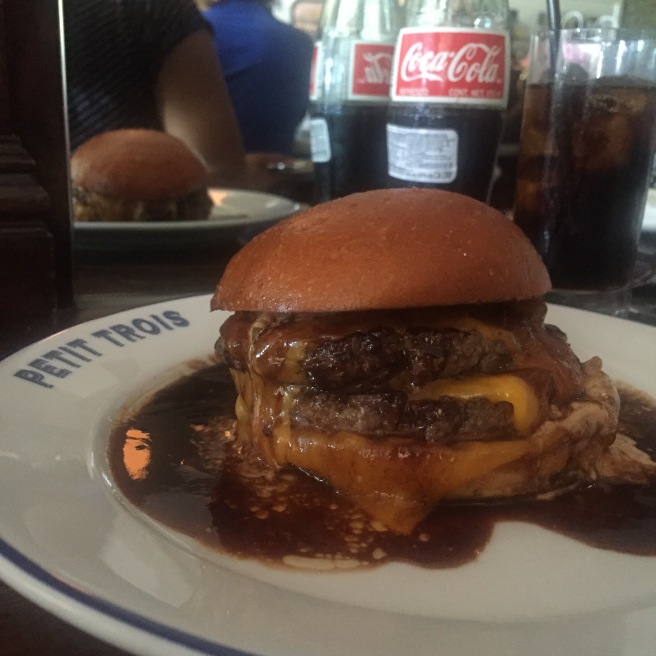The Place
The Pub at Golden Road Brewery
5410 West San Fernando Road
Los Angeles, CA 90039

Nestled in the crook of the 134 and 5 freeways, maybe you saw the violent azure of the Golden Road Brewery, a cartoonish oasis in that weird part of town that’s not quite Glendale, not quite Burbank, not quite Atwater. Maybe you heard about it after a Golden Road brewpub popped up at Grand Central Market or Dodger Stadium (thanks, Anheuser-Busch InBev). Maybe you wanted to know whether Los Angeles actually does craft beer. It really doesn’t matter much, once you’re here.
Maybe you lacked the foresight to take an Uber, in which case you’ll stubbornly scan the nearby streets for a (scarce) parking spot before wisely throwing in the towel and paying for the valet. But what’s waiting for you in this Smurf-hued warehouse (next to two others – one red, one yellow) is one of the more singular spaces in the city. A massive brewpub, serving close to two dozen beers, fully equipped with a (wood) ping-pong table and a (sheet metal) cornhole, Golden Road initially seems like something of an adult playground.
But then you’ll notice an area more closely resembling an actual playground, and you’ll see servers adeptly dodging the swerving, sprinting toddlers that abound in this place, roaming free as if in a Chuck-E-Cheese’s. After a few minutes, you realize this is actually a family space, a place for a thirty-something to find echoes of a social life she thought she’d lost after getting a time-consuming job, setting down roots, paying a mortgage, and all that. It’s a place to gather. A place where buzzed fathers can play ping-pong with their kids. It’s simultaneously heartwarming, disconcerting, charming, concerning, and profoundly odd.
After settling into the weirdness (or, depending on your proclivities, after a pint or two) you might notice the menu’s surprising bursts of sophistication. One of the items featured is a burger, which bears the brewery’s name (albeit acronymally). Sam, my guest of honor from Boston, his friend Brandon, Kelsey, and I went to try the burger (joined later by Nikhil the workaholic). In a rare moment of social inhibition, I listened to Brandon criticize Dodger Stadium; but because we had just met, I refrained from releasing the full vitriolic flood of noble rage such heresy deserved. Unsurprisingly, that choice has since left me in a fugue state perpetuated by paralytic, self-loathing regret. It is, then, from the cusp of seething, shame-ravaged catatonia that I write this. Brandon, if you’re reading, thanks a lot…and you’re welcome.
The Order: GRB Burger
The Price: $12.00
The Burger
The great thing about Golden Road beer, if you’ve not had it, is that it makes fresh presentations feel familiar. Their Wolf Pup Session IPA – likely among the best session IPAs you’ll drink at the price point – is a playful, citrusy offering that embodies this interplay between familiar and challenging. Tangy, sweet orange peel gives way to the crisp bitterness yielded by a litany of hops (the hard-charging bitterness of Simcoe providing a crackling backdrop for the complex acidity of Mosaic and a bunch of others that I don’t know nearly enough to name).
Anyway, the point here isn’t to showcase how little I know about beer. It’s just to give you an idea of what Golden Road is all about. Which brings us to the menu. Fundamentally, this is bar food. Pretzels, garlic fries, chips and guacamole, artichoke dip, and steak sandwiches are unsurprising fare to find on offer at a brewery. But read through more carefully, and you might conclude that these standard offerings are really just culinary ballast on a menu, there to allow for bursts of quirkiness. Idiosyncratic items like a burger with a beet-centric patty, fried avocado tacos, a salmon sandwich with ginger lime slaw, and pulled pork verde are among the expressions that evidence an experimental itch.
The burger reflects that. The first item of interest is the patty. A blend of short-rib and rib-eye cooked pink, it’s gorgeous, complex, marbled, sweet. It melts as you chew it. It is an attention-grabbing centerpiece. It dominates the news cycle of every bite. It is a stand-alone item, an estimable entree in itself. Its complexity of flavor allows it to reach out and connect with every other ingredient, giving the burger a balanced coherence, where everything seems put in place to complement the patty.
The other ingredients are high-minded classics. The bacon is hazily savory, with only faint smokiness; it plays predictably nicely with the smooth, ruddy aged cheddar. Caramelized onions impart singed sweetness. Sun-dried tomatoes work surprisingly well, giving each bite welcome textural subtlety and mellow ripeness. The remoulade is distantly piquant, pleasant enough but not arresting. The bun, a straightforward brioche bun dusted with sesame and poppy seeds, is a sweet bookend to it all, with the seeds offering a lingering, complicated nuttiness.
Golden Road’s heart venerates the classics, but presents them in a cerebral, updated fashion. That’s a fitting duality for a place that seems designed to let people slipping into middle age relive their youth, and put away a few pints while pretending their metabolisms are what they’ve always been. At the risk of getting too misty-eyed in our analysis, let’s be clear: this is bar food, and bar food is bar food. So I would discourage getting your hopes too high. But, for those whose relationship with day drinking is something akin to, “These days, I feel worse and know better,” a GRB Burger and a Wolf Pup or three marks a nice escape from the new normal.
The Ratings:
Flavor: 8.20 / 10.00
Freshness/Quality: 8.00 / 10.00
Value: 8.00 / 10.00
Efficiency: 8.50 / 10.00
Creativity/Style: 7.90 / 10.00
Bun: 8.90 / 10.00
Patty: 10.00 / 10.00
Toppings: 8.20 / 10.00
Sauce: 7.70 / 10.00
Balance: 9.20 / 10.00
Total: 84.60 / 100.00
 It feels like October has been all about the Chicago Cubs and their date with destiny. They’re the latest beneficiary (see also 2004 Red Sox, 2010 Giants, 1998 Jay-Z) of the special treatment we give to baseball teams that are awful for long enough. After over a century of losing, the Cubs – finally – are good. And like the Red Sox, the Giants, and Jay-Z before them, the entire nation (but for we select few who don’t share the impulse for alacritous bandwagoneering) will love them until they finally win. Then we’ll revile them for doing the very thing we hoped they’d do all along. To be a “lovable loser,” you have to keep losing.
It feels like October has been all about the Chicago Cubs and their date with destiny. They’re the latest beneficiary (see also 2004 Red Sox, 2010 Giants, 1998 Jay-Z) of the special treatment we give to baseball teams that are awful for long enough. After over a century of losing, the Cubs – finally – are good. And like the Red Sox, the Giants, and Jay-Z before them, the entire nation (but for we select few who don’t share the impulse for alacritous bandwagoneering) will love them until they finally win. Then we’ll revile them for doing the very thing we hoped they’d do all along. To be a “lovable loser,” you have to keep losing. Winsome is not on Sunset Boulevard. Head west down Sunset (away from Downtown) and as you pass Beaudry, you’ll see the Holy Community Church on your right. Beyond that, you’ll see a new apartment building made of white stone and glass. Just past the church, make a right on to White Knoll Drive. That’s where Winsome is, in the ground floor of the aforementioned stone and glass building. Just a public service announcement, lest you wind up wandering aimless and befuddled down Sunset like Kelsey, Erin, and I did (that is, until finally we gave up and called the restaurant to whimper a desperate request for directions).
Winsome is not on Sunset Boulevard. Head west down Sunset (away from Downtown) and as you pass Beaudry, you’ll see the Holy Community Church on your right. Beyond that, you’ll see a new apartment building made of white stone and glass. Just past the church, make a right on to White Knoll Drive. That’s where Winsome is, in the ground floor of the aforementioned stone and glass building. Just a public service announcement, lest you wind up wandering aimless and befuddled down Sunset like Kelsey, Erin, and I did (that is, until finally we gave up and called the restaurant to whimper a desperate request for directions).

 Santa Monica on a summer weekend truly is an incredible thing. The beautiful, sun-bronzed masses take to the streets in outfits carefully chosen to reveal the fruits of a winter spent in pilates classes, or of the paleo diet, or of thousands of dollars in Equinox membership fees or CrossFit classes, or of the latest juice cleanse.
Santa Monica on a summer weekend truly is an incredible thing. The beautiful, sun-bronzed masses take to the streets in outfits carefully chosen to reveal the fruits of a winter spent in pilates classes, or of the paleo diet, or of thousands of dollars in Equinox membership fees or CrossFit classes, or of the latest juice cleanse.
 When Courtney texted me today and asked me if I wanted to go to Flintridge Proper to help her put off packing for a bit (she’s moving to Pasadena, the genius), I thought it would just be a good opportunity to hang out with her, grab a drink, and unwind after a long (half) week of studying. Little did I know, it would bring out the most judgmental iterations of both of us. Out of consideration for her (and okay fine, myself), I’ll refrain from relating many of our reactions to the people around us at The Proper. Instead, I’ll limit my discussion to their excellent burger.
When Courtney texted me today and asked me if I wanted to go to Flintridge Proper to help her put off packing for a bit (she’s moving to Pasadena, the genius), I thought it would just be a good opportunity to hang out with her, grab a drink, and unwind after a long (half) week of studying. Little did I know, it would bring out the most judgmental iterations of both of us. Out of consideration for her (and okay fine, myself), I’ll refrain from relating many of our reactions to the people around us at The Proper. Instead, I’ll limit my discussion to their excellent burger.